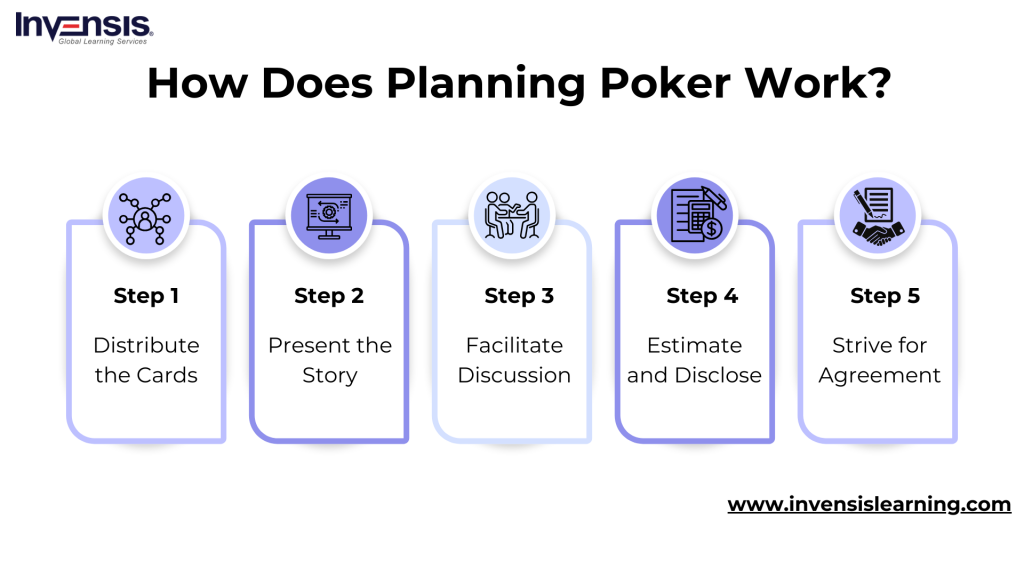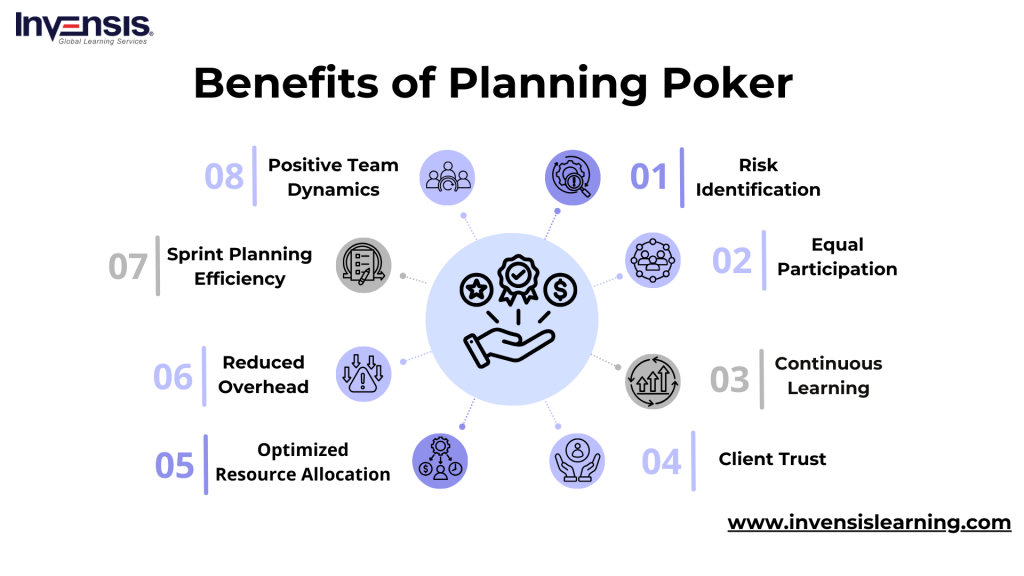
Ever experienced the uncertainty of estimating Agile tasks? Don’t worry. Imagine, though, if there were a lively and collaborative method to infuse clarity and confidence into the process. That’s where Poker Planning comes in – a technique turning estimation from a solo task into a lively team game.
This approach addresses accuracy and communication challenges, leading to realistic timelines and enhanced teamwork. Planning Poker injects energy into teams, turning estimation into a fun, game-like experience that builds trust and encourages collaboration.
This blog will explore the mechanics, benefits, and process of planning poker, providing a clear and professional guide for those looking to enhance their Agile estimation process.
Table of Contents:
- What is Planning Poker?
- How Does Planning Poker Work?
- Why is Planning Poker Used in Agile?
- Which Organizations Should Use Planning Poker?
- The Benefits of Planning Poker
- What is the Planning Poker Estimation Technique?
- Conclusion
What is Planning Poker?
Planning Poker, also known as “Scrum Poker,” is a collaborative and interactive estimation technique used in Agile project management. It involves a group of team members, including developers, designers, and testers, coming together to estimate the effort required for each user story or task in a project.
Instead of using traditional methods like individual guesswork or numerical estimation, Planning Poker employs a deck of cards with values representing the complexity or effort involved in a particular task. Team members simultaneously reveal their chosen cards, which initiates a discussion.
This allows the team to consider different perspectives, share insights, and reach a consensus on the effort required. The process not only improves the accuracy of estimations but also fosters team collaboration, communication, and a shared understanding of the project’s scope and requirements.
Utilizing Poker Planning cards involves estimating the story points for each narrative and initiating discussions to finalize the estimations. This methodology aims to improve companies’ precision in estimating timelines and foster stronger teamwork.
While Planning Poker sessions are enjoyable and uplifting, the software industry recognizes the essential role of collaboration and interaction in ensuring alignment and swift product delivery. Integrating Planning Poker into your project reinforces adherence to agile principles.
How Does Planning Poker Work?
Planning Poker is a collaborative and participatory Agile estimation technique designed to facilitate accurate project planning and enhance team communication. It assembles stakeholders from various departments within an organization to agree on the estimated effort required for different backlog initiatives.
In the context of an agile software organization, stakeholders may encompass roles such as product owners, developers, UX designers, QA testers, and product managers, among others. Here’s how planning Poker typically works:
Step 1: Distribute the Cards
All participants receive an identical deck of cards (or chips), each featuring distinct numbers. One common sequence, often suggested by Mike Cohn of Mountain Goat Software, involves numbers like 0, 1, 2, 3, 5, 8, 13, 20, 40, and 100. The limited deck with a significant number of intervals ensures efficiency in the process, preventing overwhelming options.
Step 2: Present the Story
Subsequently, the product owner (or a product manager) reads each story aloud to the group.
Step 3: Facilitate Discussion
Now that everyone is familiar with the story, the group engages in a discussion. Participants share their perspectives on how to approach the work, estimate the number of people involved, identify necessary skill sets, and anticipate potential obstacles. This phase also allows for questions about the story.
Step 4: Estimate and Disclose
After participants express their opinions and address queries, each individual privately selects a card from the deck to represent their story points estimate. Once ready, all participants simultaneously reveal their cards.
The higher the card value, the more challenging the participant perceives the story to be completed.
Step 5: Strive for Agreement
If all participants reveal the same card, it becomes the consensus, and the group can proceed to the next story. However, if the cards differ, the group continues discussing the story. Those with higher or lower estimates elaborate on their reasoning, attempting to persuade their colleagues.
After this round of discussion, participants review their cards, choosing to maintain their initial choice or select a new one. Once again, all participants simultaneously reveal their cards.
Why is Planning Poker Used in Agile?
Planning Poker is utilized in Agile methodologies to enhance collaborative estimation and improve accuracy in project planning. Involving stakeholders like product owners, developers, UX designers, QA testers, and others, Planning Agile Poker uses a gamified approach, employing cards with values often based on a Fibonacci sequence.
This non-linear scale accommodates the complexity of different tasks, fostering complexities and accurate estimations. The technique encourages open communication during estimation rounds, ensuring diverse perspectives are considered and leading to a shared understanding of project requirements.
Planning Poker promotes consensus building by repeating estimation rounds until the team converges on a collective estimate. This iterative technique accepts differing viewpoints, allowing team members to collectively discuss and revise their estimates.
Planning Poker leads to excellent team dynamics and the successful application of Agile techniques in project management by adhering to Agile Project Management principles of collaboration, responsiveness to change, and producing value.
Which Organizations Should Use Planning Poker?
Planning Poker is beneficial for organizations that embrace Agile methodologies, especially those involved in software development or project management. Here are the types of organizations that can greatly benefit from using Planning Poker:
-
Software Development Companies
For companies specializing in software development, where Agile practices are widely embraced, Planning Poker becomes a valuable tool. It facilitates more accurate estimations and collaborative planning sessions, aligning well with the iterative and adaptable nature of Agile development.
-
Agile Teams and Scrum Environments
Agile teams, particularly those following frameworks like Scrum, can seamlessly integrate Planning Poker into their sprint planning sessions. This approach resonates with Agile principles by emphasizing iterative development cycles and the ability to adapt to changing project requirements.
-
Project Management Focused Organizations
Organizations with a strong focus on project management, regardless of their industry, can benefit significantly from the streamlined estimation process that Planning Poker offers. It ensures that project timelines are realistic and aligned with the organization’s overall goals.
-
Product Development Teams
Whether involved in software, hardware, or a combination of both, organizations with a focus on product development can leverage Planning Poker to estimate the effort required for various features and functionalities. This is particularly beneficial when dealing with complex and multifaceted projects.
-
Cross-Functional Teams
Organizations emphasizing collaboration across diverse roles, such as developers, designers, testers, and product owners, find Planning Poker an excellent way to incorporate multiple perspectives into the estimation process. This collaborative approach enhances the accuracy of estimations and promotes a holistic understanding of project requirements.
-
Companies Emphasizing Collaboration and Communication
Organizations placing a high value on open communication, teamwork, and collaboration can integrate Planning Poker to reinforce these principles during project planning and estimation activities. The method encourages active participation and engagement from all team members.
-
Startups and Small Businesses
Startups and small businesses, often characterized by dynamic environments and resource constraints, can derive significant benefits from Planning Poker. It offers an efficient and collaborative approach to project planning, allowing these organizations to make the most of their limited resources.
-
Any Organization Adopting Agile Principles
Planning Poker is adaptable and applicable to any organization in the process of transitioning to, or already following, Agile principles. By incorporating Planning Poker into their project management practices, these organizations can enhance the accuracy of estimations, foster collaboration, and better navigate the complexities of Agile project development.
Planning Poker is versatile and can be adapted by organizations of varying sizes and industries as long as they embrace Agile values and seek to improve their project planning and estimation processes.
The Benefits of Planning Poker
Using Planning Poker in Agile project management brings forth several notable benefits, enhancing the efficiency and effectiveness of the estimation process. Here are key advantages associated with the use of Planning Poker:
- Risk Identification: Planning Poker helps identify potential risks associated with tasks, allowing for proactive risk mitigation strategies
- Equal Participation: Anonymity in card selection ensures equal participation, fostering engagement and a democratic approach
- Continuous Learning: The iterative nature encourages continuous improvement, allowing teams to apply lessons learned from each round
- Client Trust: Provides transparency to clients about task complexities, managing expectations, and building trust through their involvement
- Optimized Resource Allocation: Accurate estimations enable effective resource allocation, aiding project managers in workload distribution and capacity planning
- Reduced Overhead: The collaborative nature minimizes the need for extensive documentation, reducing administrative overhead
- Sprint Planning Efficiency: Crucial for sprint planning, Planning Poker ensures accurate estimations, contributing to the success of Agile sprint planning
- Positive Team Dynamics: Encourages mutual respect and understanding, fostering positive team dynamics and a motivated working environment
What is the Planning Poker Estimation Technique?
Planning Poker is an Agile estimation technique that amalgamates elements from three distinct estimation methodologies: the Wideband Delphi Technique, PERT Software Testing Estimation Technique, and Estimation using Work Breakdown Structure (WBS). Here’s an overview of how these techniques are integrated within Planning Poker:
-
Wideband Delphi Technique
The Wideband Delphi Technique is a consensus-based estimation approach where a group of experts provides independent estimates for a task, followed by a facilitated discussion to reach a consensus.
In Planning Poker, team members individually select Planning Poker cards representing their estimates, mimicking the independence of expert opinions. The subsequent card reveal and discussion phases mirror the collaborative consensus-building characteristic of the Wideband Delphi Technique.
-
PERT Software Testing Estimation Technique
PERT (Program Evaluation and Review Technique) is a project management and estimation technique that is often used in software testing. It involves analyzing and estimating the time required for each task in a project, considering three time estimates: optimistic (O), pessimistic (P), and most likely (M).
The formula for calculating the expected time (TE) is TE = (O + 4M + P)/ 6.
Here’s how PERT is typically applied to software testing estimation:
- Optimistic Time (O): The optimistic time is the minimum time required to complete a testing task under the best-case scenario
- Pessimistic Time (P): The pessimistic time is the maximum time required, assuming everything that could go wrong does go wrong
- Most Likely Time (M): The most likely time is the best estimate of the time required under normal conditions
- Expected Time (TE): The expected time is calculated using the PERT formula: TE = (O + 4M + P) / 6. It provides a weighted average that considers optimistic and pessimistic scenarios, giving a more realistic estimate of the time required
To determine the Standard Deviation, use the formula:
Standard Deviation (SD) = (E ? O)/6
-
Estimation using Work Breakdown Structure (WBS)
Work Breakdown Structure is a project management technique that breaks down a project into smaller, more manageable components. In Planning Poker, each user story or task serves as a component, and the team collectively estimates the effort for each. This aligns with the principles of Estimation using WBS, where the project is divided into hierarchical levels, making it easier to estimate and manage.
Conclusion
Planning Poker in Agile stands out as a transformative and collaborative technique that transcends traditional estimation methods. The gamified approach, with its unique card-based mechanics, injects a sense of engagement into the estimation process, breaking down silos and promoting a positive team culture.
As the team converges on consensus estimates, Planning Poker emerges as a tool for accurate project timelines and a catalyst for camaraderie and ownership. It’s a powerful strategy that improves planning precision and transforms estimation sessions into collaborative and interactive experiences for Agile teams.
Ready to elevate your Agile project management skills? Explore Invensis Learning’s Agile Certification Courses today. Gain in-depth knowledge of Agile methodologies and an accredited certification that will set you apart in the dynamic world of Agile project management. Seize the opportunity to lead with agility, drive project success, and propel your career forward.
















